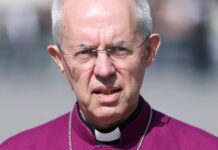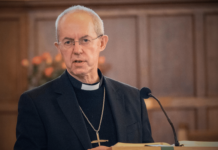In February’s General Synod, two of the divisive looming questions are: introducing standalone services for same sex couples experimentally using Canon B5A; and whether we should “reset” the LLF process.
This article asks if, rather than polarise again around these two issues, an apparent consensus on the need for greater honesty and transparency may also help with clarifying and answering the “B5A or not B5A?” question. After noting the sudden appearance of the “standalone” category and use of Canon B5A within the PLF process during last summer, it traces the convoluted “hokey-cokey” history of Canon B5A through the College in September (“in”), House in October (“out”) and Synod in November (“in”) to the current (“shake it all about” possibly leading to a decision to “turn around”) situation.
In doing so it raises ten questions focussed on legal matters and the bishops’ legal advice in order to try to uncover the rationale for the rapidly changing positions of archbishops and bishops, with the hope that greater clarity here might enable better mutual understanding and discernment going forward.
As we await the papers for General Synod, due out at the end of this week, it appears from the recent article by the then co-lead bishops (currently reduced to a single lead bishop, the Bishop of Leicester, following the resignation of the Bishop of Newcastle) that a “reset” of the Living in Love and Faith (LLF) process will be proposed. This will be in order to seek, on the basis of some proposed “commitments”, an agreed “settlement”. The next steps would therefore not involve proceeding to introduce experimental “standalone services” using Canon B5A or new pastoral guidance to replace Issues, drafts of which have indicated it would open up same-sex civil marriage to clergy. Rather, to return to comparisons with Brexit, it would be more a case of “nothing is agreed until everything is agreed”. The aim would be to find a whole package including pastoral reassurance, probably in the form of providing new “structural provision” that recognises the depth of our disagreements. This possible new direction of travel has not been received well by those pressing for change.
One particular concern for many is that this path will delay, perhaps for a year or more, the introduction of “standalone services” for same-sex couples using the Prayers of Love and Faith (PLF) resources. Those resources were commended by the bishops in December but only for use in regular services where they could not be the focus of the service. This delay, first proposed by the House of Bishops in their 20th October paper to the November General Synod, was thought to have been overturned and prevented by the Synod when it passed (by only a majority of 1 in the House of Laity) an amendment from the Bishop of Oxford. The final motion therefore requested the House of Bishops “to consider whether some standalone services for same-sex couples could be made available for use, possibly on a trial basis”. This was widely understood to be a request for the Archbishops to use their authority under Canon B5A to authorise standalone services on an experimental basis rather than waiting, as originally proposed, for authorisation only through the lengthy and uncertain Synodical process under Canon B2.
There is the risk that this issue will now become a new flashpoint: those wanting standalone services objecting that Synod is being ignored if experimental services are not authorised soon, those not wanting such services welcoming this delay. Having previously argued that the key question was “B2 or not B2?”(there is a short summary here, with full PDF text here) that has been settled in favour of “not B2” for the prayers now commended for use under Canon B5. It appears that “B2” has probably now also become a settled answer for “standalone services” but that raises the question of “B5A or not B5A?” as an experimental authorisation before or alongside the Canon B2 process.
Rather than rushing into making this a new stand-off along the usual fault-lines it may be better instead to step back and look at how we have ended up here and identify questions it would be very helpful to have clarified.
Among the commitments being proposed are “honesty and transparency” and many—across our divisions—are increasingly concerned that transparency and perhaps honesty have too often been in scarce supply in this process for some time. What follows draws on a much lengthier and more detailed chronological account to highlight the key stages that have led us to this new focus and potential impasse on “B5A or not B5A?”. It raises ten questions that need answering, even if giving these answers may require from Archbishops, bishops and the central church structures, two other “basics” which have been proposed as commitments in the reset: “humility and repentance”.
Standalone services?
Before focussing on “B5A or not B5A?”, there needs to be a clearer explanation answer to the first question that helped generate it:
- How and why between the July General Synod and the meeting of the College of Bishops (from 18th to 21st September) was this new sharp distinction between “regular” and “standalone” services created and how and why were different canonical routes proposed for each category?
Both legal advice and political pressures may have contributed to introducing this stark separation within the PLF drafts presented in February and July. However, as I sketched when it was formally announced, it raises numerous questions. It was interesting that, when pressed for “a definition for a standalone service…as a general principle”, the Bishop of London had to tell the Synod member asking (p53), “I can get an answer written to you…I know somebody who knows”.
Once this distinction was put in place the bishops appear to have been all over the place in relation to the introduction of the standalone services. There are three distinct phases in relation to Canon B5A from the September College through the October House to the November General Synod. These phases can be thought of as representing a sort of episcopal and archiepiscopal hokey-cokey with each step raising important questions, particularly in relation to the changing substance, interpretation and use of (all of it unpublished) legal advice. Such legal advice must surely be a central element in due process for any decision-making, particularly decisions concerning which canons are legitimate, best suited and least risky if we are to introduce controversial new liturgy into the life of the church.
Putting B5A in
At the September College of Bishops it appears, from a subsequent leak which has never been corrected or confirmed, that in two indicative votes the bishops (a) overwhelmingly supported a plan to introduce the standalone services on an experimental basis under Canon B5A and (b) also strongly rejected the option to leave their introduction until the end of the Canon B2 process. Given the importance of this apparently strong consensus the second question arises as to
2. What legal advice existed at this initial stage of the bishops’ consideration in relation to the “B5A or not B5A?” question and what did such advice state?
Putting B5A out
At the November General Synod, when asked for “some more clarity on why there was a sudden change in the decision to go from B5A to B2…probably around October the 9th”, the Bishop of London objected “there was not a sudden change…I do not think it was sudden” (Proceedings, pp 55-56). The reality is, however, that I and many others (including Professor Helen King, Vice-Chair of the General Synod Gender & Sexuality Group) were told by the bishop in various meetings a week before the House of Bishops that the proposal that was to be put involved (1) commending the suite of prayers for use under Canon B5 as proposed to, and supported by, Synod in February but (2) bringing standalone services to Synod under Canon B2 along with an experimental period authorised under Canon B5A.
On 9th October at the House, however, the Bishop of London instead proposed going straight to Canon B2 without an experimental period using Canon B5A. This was strongly supported by the Archbishop of Canterbury. The vote, it is reported, was tight (19 for but 16 still wanting to use B5A) but it was announced that evening in a press release which explained that
Bishops gave serious consideration to an alternative legal process which could have enabled special services to be authorised almost immediately—but temporarily—(under Canon B5A). This would still have required a further process for the services to be authorised permanently (under Canon B2) by Synod.
The Bishop of London also explained in the press release (with no mention that this was a major reversal of the recent recommendation of the College) that the House
have agreed to commend Prayers of Love and Faith and also considered the best way to authorise special standalone services. Having carefully considering [sic] the legal, theological and pastoral implications of possible approaches, the bishops concluded that it would ultimately be clearer to proceed directly to consideration under Canon B2. We acknowledge that there are some who would like this process to move faster, however the move to full authorisation will provide clarity and wide consultation ahead of a final decision by synod in 2025.
Two further key questions raised by this process and statement are:
- What were presented to the bishops as the “legal, theological and pastoral implications of possible approaches” that led them now to conclude, after consideration, in favour of Canon B2 and to reject the use of Canon B5A?
- Was this change in proposed canonical processes agreed by the House in October due to the legal and theological advice now being offered to them having become, in an iterative process, different from that which had been offered to the College in September in relation to the use of Canon B5A?
Less directly related to the “B5A or not B5A?” question, but not unconnected to it given concerns about legal challenges to the Archbishops if they used Canon B5A, there is also the question
- Why, in a dissenting statement, did a dozen bishops at the House state that “legal and theological advice the House has received suggest clearly to us that the decisions of the House may fall short” of the bishops’ declared intention (and the requirement within the February General Synod motion) that “the final form of the prayers should not be “indicative of a departure from the doctrine of the Church of England””?
Three weeks later, on 20th October, the House published its full proposals to bring to the November General Synod in GS 2328. This led to major and understandable critique from those pressing for change and the leaking of the contrasting voting figures between College and House. GS 2328 makes no mention at all of Canon B5A or an “experimental” option. The only hints as to why the Archbishop of Canterbury, the Bishop of London, and a narrow majority of bishops had changed their mind are found in para 10 of the covering paper:
The third section of the Prayers contains the forms of service to be used for separate, standalone services (those outside of existing regular worship). These forms of service will not be commended, but will follow the process for liturgical authorisation under Canon B2. Following the Canon B2 process for these services will provide the firmest footing for those using them within the shortest possible timeframe. It will provide reassurance concerning legal challenges, both for those who wish to use the prayers and for those who do not. It will also regulate the form in which this material can be used, and enable an opt-in approach to provide clarity and transparency about which churches have decided to offer them.
The two central arguments for B2 but “not B5A” here appear to be in relation to speed (“the shortest possible timeframe”) and security (“the firmest footing for those using them…reassurance concerning legal challenges”) and both these themes were strongly present in written answers to questions released on 10th November (e.g. Questions 2, 24, 53, 57, 60, 73). One of those answers also clearly stated that “The proposal that the standalone PLF services should be introduced in the General Synod for approval under Canon B 2 was a collective decision of the House of Bishops” (Q73).
In the light of this, an additional sixth question arises
- What legal advice was being given to the bishops at this stage concerning (a) the respective speeds of the “B5A or not B5A?” question in relation to the B2 process and (b) the different legal risk assessments of “firmness of footing” and “reassurance concerning legal challenges” in relation to these two possible canonical routes?
These are particularly important because within three days of the answers being published it began to become clear that, led by the Archbishops and the Bishop of Oxford, with the support of the Bishop of London, the majority of the House of Bishops were now engaging in a “reverse ferret” to support “B5A in”. They would do so while simultaneously claiming, in the face of repeated requests from Synod members to be able to see their legal advice, that the legal basis for their position was not being “hidden” as it was all set out in the papers that argued, paradoxically, for “B5A out”.
Putting B5A in again
In proposing his amendment (effectively to return to Canon B5A), the Bishop of Oxford confirmed an earlier comment by the Bishop of London (in answering a question) that legal advice in relation to the relative speed of the “B5A or not B5A?” options had apparently recently changed. She had said:
The further clarity has been that, actually, you could run experimental services alongside the B 2, which is where the amendment comes from (p. 56).
The Bishop of Oxford in proposing his amendment stressed that it would “enable those services to be celebrated much sooner, and during the Canon B 2 process” (p. 252).
No mention was made of the other argument in relation to security or whether the move to run Canon B5A alongside Canon B2 (rather than before it and then having to withdraw it leaving no authorised service in place) now meant “B5A” rather than “not B5A” provided “the firmest footing” or the greatest “reassurance concerning legal challenges”. It may have done or it may have been a political judgment that even if legally riskier, opposing the amendment and sticking with “not B5A” might lead those wishing standalone services to join conservatives in voting down the whole motion.
These points were powerfully made in the first speech opposing the amendment, by Kate Wharton (Prolocutor of the Lower House of the Convocation of York):
Read it all at Psephizo










